- Home
- Views On News
- Jan 20, 2022 - JLR, Corus, Tetley - Was Ratan Tata's Go Global Strategy Right Afterall?
JLR, Corus, Tetley - Was Ratan Tata's Go Global Strategy Right Afterall?
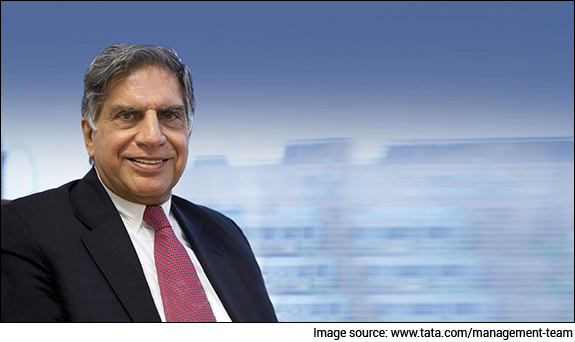
When it comes to globalisation by Indian companies, the Tata Group is the first name that springs to mind.
Right from humble beginnings when its founder, Jamsetji Nusserwanji Tata started his business career in 1868 trading with China, the Tata group has always had a global outlook.
However, it was Ratan Tata who took the Tata group truly global, in turn, creating an international empire.
As early as 1983, when JRD Tata, his predecessor asked him to draw up a blue print for the future, Ratan Tata recommended the group seek growth internationally. He wanted to restructure the group to address the global opportunities.
Ratan Tata's appointment as chairman of the Tata group in 1991 coincided with the year when India launched economic reforms.
At a time, globalisation was a new concept in India. Ratan Tata took the lead not only in big acquisitions but also in changing the mindset of India's top business leaders.
Beginning with Tata Tea's acquisition of Tetley in 2000, Tata went on a shopping spree acquiring as many as 36 companies in just 9 years.
Among them, the most noteworthy and possibly controversial acquisitions till date have been the Tetley acquisition by Tata Tea, Tata Steel's takeover of Anglo-Dutch steel maker Corus, and the British automobile marquee Jaguar and Land Rover by Tata Motors.
Ratan Tata became the poster boy for leading the group towards a daring 'reverse colonialism.'
There was tremendous outpouring of nationalistic euphoria and economic patriotism in the Indian markets at the time. The new India was poised for global supremacy and Tata was spearheading 'The Global Indian Takeover'.
However, the Tata Group's global strategy, particularly in the UK, has been severely tested.
Its international acquisitions, particularly Corus, was made at the peak of the boom just before the 2008 financial crisis. This dealt a severe blow to its European operations.
With problems subsequently worsened by Brexit and trade wars, Europe's steel industry never fully rebounded from the 2008 financial crisis.
Tata was criticised by analysts to pull back and refocus on India, where rising incomes, consumption, and internet use, among 1.4 billion people, made Europe look comparatively less promising.
The Tata Group also faced difficult questions about its international scorecard. Former chairman Cyrus Mistry, who was engaged in an acrimonious court dispute with the group over his 2016 ousting, argued in court filings, 'a set of ill-conceived global acquisition[s]' contributed to 'the largest value destruction in Indian corporate history'.
By contrast, the Reliance group's much more 'India-focused' strategy seemed to have worked far better over the same period.
Significantly, Reliance has invested more in India than any other private firm. It believes that given India's demographics, its growth is far more sustainable than that of the rest of the world.
Was the Tatas Global Strategy Right after all?
Let's try and answer this by focusing on the three largest acquisitions made by Tata.
Tetley:
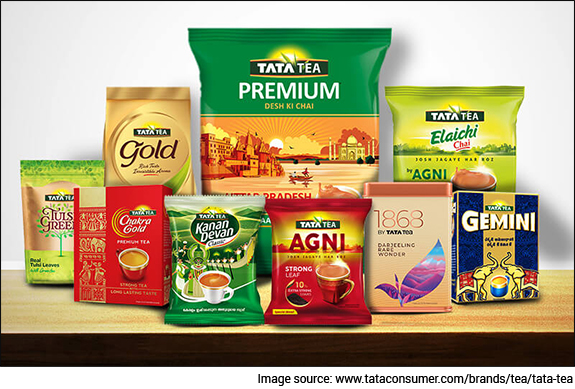
In the late 1990s, Tetley had become the world's second-largest tea brand after Lipton.
Tata Tea on the other hand was the largest tea grower in the world.
The Tatas realised that despite having over 50 tea gardens across India, they didn't have a brand. Cyclical price fluctuations made the commodity end of the business loss-making.
By contrast, Unilever with very few gardens was buying their bulk tea in auctions and selling them in pouches at huge profits.
The leadership thought Tata Tea should transition from trading to branding in the long haul. It needed its very own, well-known tea brands.
When the owners of Tetley decided to sell their brands, Tatas immediately grabbed the opportunity as it fit in very well with their long-term strategy.
The Tatas beat other bidders such as Nestle and paid an acquisition price for the worldwide Tetley Tea business of £271 m.
The Tetley deal was hailed as the first-of-its-kind in the world. It had acquired Tetley, which was nearly four times its net worth. Many called this 'the audacious acquisition of a global shark by an Indian minnow'.
It was the largest cross-border acquisition of an international brand by an Indian company.
The acquisition of Tetley leap frogged Tata Tea into a position where it could rub shoulders with global behemoths like Unilever and Lawrie. It made Tata Tea the second biggest tea company in the world.
The aftermath of the acquisition was not as pleasant as anticipated. There was the array of vertical integration synergies, but the leveraged buyout structure, cultural differences, and lack of planning meant the realisation of the synergies was delayed.
The difficulties were exacerbated by the cyclical downturn in the tea industry and the increased competition from substitute products.
The Tetley acquisition was perceived negatively by the market for the next three years.
However, the company carefully chose an approach to integrate the processes and explore synergies between the two companies with absence of any time pressures, while maintaining operational independence.
The emphasis throughout was on revenue growth and not on cost reduction.
Ratan Tata's vision of Tata Tea as a global beverage company has been realised over the years.
What used to be Tata Tea has now morphed into Tata Consumer Products, one of India's most exciting consumption plays.
Today the company with a global management structure encompasses all acquired companies and joint ventures with popular brands, including Tetley, Tata Tea, Tata Coffee, Eight O' Clock Coffee, Himalaya, and many others.
Starbucks, the largest coffeehouse company in the world inked a 50:50 joint venture with Tata Consumer Products Ltd in 2012. Since then, the brand has grown from strength to strength.
Tata Consumer Products has become the most globalised company in the Tata Group with 70% of its revenues coming from international operations, and more people around the world drinking Tata Tea than using Tata vehicles, Tata steel, or even TCS software!
For the capitalists among us, here's a look at how the company has performed on the stock market...
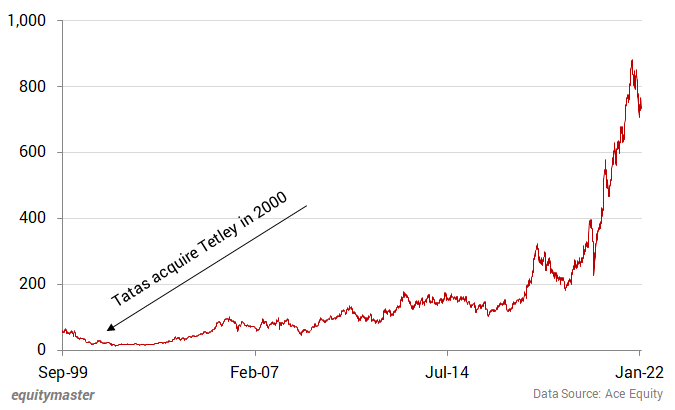
It's clear that anyone who bet on Tata Tea's global ambitions, did well.
So, that's 1 for Tata, and 0 for critics.
Corus:
Tata bought Corus for an eye-watering US$13.1 bn in 2007 after winning a dramatic head-to-head bidding war against a Brazilian rival.
It instantly catapulted Tata Steel into the ranks of the top ten steelmakers in the world with an annual capacity of 25 m tonnes.
While the Indian industry lauded Tata Steel's move, there was national debate about whether Tata Steel had overpaid for the Corus acquisition.
Ratan Tata described it as a defining moment for the company and justified the price by saying that the deal gave them immediate access to the mature European markets.
Building a greenfield plant could have taken Tatas up to 5 years and the investment could have been higher.
The Tata Steel stock took a beating on the announcement of the deal given the high level of debt the company would have to take to finance it.
At the time, Ratan Tata said the market would come round.
- "Quite frankly I do feel it is both taking a short-term and harsh view... In future somebody will look back and say we did the right thing," he told reporters in Mumbai.
Unfortunately, Tata Steel's European foray soon proved problematic. Not only was it expensive - a 68 % premium to the Corus share price pre-bid - but it coincided with the peak of the commodities boom.
The damage was compounded by China dumping cheaper steel in Europe after other large markets including US and India increased tariff barriers.
Corus added over US$6 bn in debt and cost Tata Steel its financial health and leadership in the home market.
12 years after it made the ambitious acquisition the company acknowledged it bet on the wrong market, at the wrong time. Since then, it has reduced the firm's steel manufacturing capacity from 18 to 10 m tonne per annum.
The finalisation of the joint venture with Thyssenkrup AG in 2018 marked the end of a long, painful chapter in Tata Steel's history.
Recently, thanks to a big surge in its margins and net profit in the second quarter, Tata Steel has overtaken Tata Consultancy Services (TCS) to become the most profitable company in the Tata Group.
In hindsight, it's apparent the acquisition was a bad strategic decision, but it would have been difficult, if not impossible, to predict the Eurozone's slide into recession and the abrupt and unexpected slowdown in China.
How did Tata Steel perform on the bourses during this entire episode?
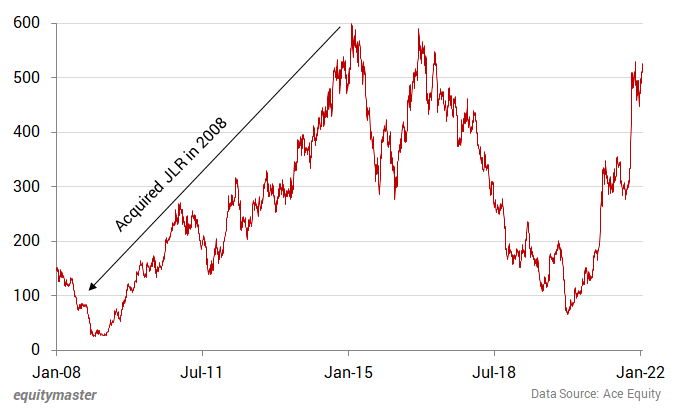
Ouch...
This, levels the score...1 for critics, and 1 for Tata.
Jaguar Land Rover (JLR):
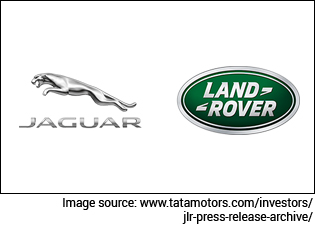
In 2008, Tata Motors acquired JLR from Ford Motor Company for US$2.3 bn in an all-cash transaction.
As the US market was slipping into recession and demand for luxury cars and SUVs were sliding, JLR was headed towards major losses.
Ford was on the verge of bankruptcy and was looking for a suitable buyer for their Jaguar - Land Rover division.
Tata saw this as an opportunity to acquire a global market and enter the luxury and high-end premium segment of the global automobile market. It also allowed the company access to superior technology which allowed them to improve their Indian core products portfolio.
Soon after the deal, Tata Motors found itself loaded with a debt of Rs 219 bn and shortly posted its first loss in 7 years. Critics felt the timing of the acquisition couldn't have been worse and were apprehensive of the future.
The stock naturally crashed.
Our very own Rahul Shah, co-editor of Profit Hunter, then made perhaps one of his best calls ever. Having studied Tata Motors - JLR, he came to the conclusion that it was time to go long on the stock. He put out an extremely contrarian report to buy Tata Motors.
The rest as they say is history. The stock tripled within the next 18 months rewarding his subscribers with multi-fold gains.
Underscoring Rahul Shah's view was the fact that the Tatas were convinced they could turn around JLR into a success story.
Ratan Tata who was directly involved in the business at the time travelled across the US, meeting dealers and responded to the market needs immediately.
By 2013, the strategy to invest in new products started to pay off. JLR almost tripled its sales in 2017 from 2009 with revenues topping US$34 bn.
The losses notched up at the domestic businesses of Tata Motors over the years have been offset by the profits earned by JLR.
The acquisition has been a great success and currently JLR contributes close to 80% of Tata Motors revenues.
Here's how Tata Motors has performed for its shareholders...
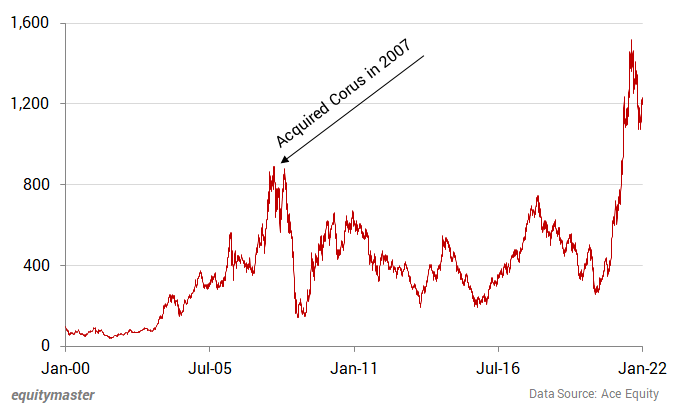
What does this to our score?
Well, it stands at 2 for Tata, and 1 for critics...
And you know what that means!
At Home Around the World:
In 2004, Ratan Tata, then Chairman of Tata Sons, summed up the Tata group's efforts to internationalise its operations thus:
- "I hope that a hundred years from now we will spread our wings far beyond India, that we become a global group, operating in many countries, an Indian business conglomerate that is at home in the world, carrying the same sense of trust that we do today."
It seems his vision has come true already. In 2020-21, the revenue of Tata companies, taken together was US$103 bn.
These companies collectively employ over 800,000 people in more than 100 countries. Over 65% of its total revenues are generated outside India.
In response to the common view that Ratan Tata was obsessed with globalisation, Tata was of the opinion that he was not obsessed but going global was an idea long overdue for the group.
This journey of globalisation made the group a US$103 bn global powerhouse in 2021 from a US$5.8 bn firm in 1992.
It is difficult to predict the perfect timing for such decisions. And that is what happened in some of the cases. It was hard for Tata Steel to predict the 2008 financial crisis.
There were setbacks such as Corus. But there is also JLR which has been a big success.
Ratan Tata had the necessary vision to understand what Anand Mahindra meant when he said, 'You are not safe at home unless you are globally competitive'.
He set out to do so with regard to most of the businesses and was quite successful at it.
At the time of the Tetley acquisition, Ratan Tata said,
- 'It is a bold move and I hope that other Indian corporates will follow'.
Indian companies did indeed follow, making deals that would strengthen and expand their operations and market share irrespective of whether or not such deals were ever made previously.
It unleashed the Indian entrepreneurial spirit backed by the world's largest free market democracy.
Mr Chandrasekaran, who took over from Tata in 2017 is equally committed to globalisation even as the group seeks new opportunities at home.
The Tata group is banking on a post-pandemic boom in India and worldwide.
- 'The focus on geographies should continuously shift depending on where the demand, where the next big opportunity is. This is not to say we're pulling out of globalisation'. - Natarajan Chandrasekaran
A few weeks ago, Ratan Tata turned 84 and even today he continues to inspire the entire nation with his zeal, integrity, and vision for a better India.
We at Equitymaster wish him a belated happy birthday!
Disclaimer: This article is for information purposes only. It is not a stock recommendation and should not be treated as such. Learn more about our recommendation services here...

Yazad Pavri
Cool Dad, Biker Boy, Terrible Dancer, Financial writer
I am a Batman fan who also does some financial writing in that order. Traded in my first stock in my pre-teen years, got an IIM tag if that matters, spent 15 years running my own NBFC and now here I am... Writing is my passion. Also, other than writing, I'm completely unemployable!


Equitymaster requests your view! Post a comment on "JLR, Corus, Tetley - Was Ratan Tata's Go Global Strategy Right Afterall?". Click here!
Comments are moderated by Equitymaster, in accordance with the Terms of Use, and may not appear
on this article until they have been reviewed and deemed appropriate for posting.
In the meantime, you may want to share this article with your friends!